Ques.31. Which of the following materials when used as the viewing surface of a CRO gives a reddish glow? (SSC-2018 Set-4)
- Zinc Sulfide with copper as an impurity
- Zinc Sulfide with silver as an impurity
- Yttrium Oxide
- Pure Zinc Sulfide
Answer.3. Yttrium Oxide Explanation:- The actual conversion of electrical to light energy takes place on the display screen when electrons strike a material known as a phosphor. A phosphor is a chemical that glows when exposed to electrical energy. The selection of phosphors to be used in a cathode ray tube is very important. Many different phosphors are known, and each has special characteristics. For example, the phosphor known as yttrium oxide gives off a red glow when struck by electrons, and yttrium silicate gives off a purplish-blue glow. Zinc sulfide with silver metal as an impurity gives off a bluish glow and with copper metal as an impurity, a greenish glow.
Ques.32. Which of the following is TRUE about current transformers? (SSC-2018 Set-4)
- It decreases the range of AC ammeter
- It decreases the range of DC ammeter
- It increases the range of AC ammeter
- It increases the range of DC ammeter
Answer.3. It increases the range of AC ammeter Explanation:- Instrument transformers are used in conjunction with ammeter and voltmeter to extend the range of meters. In dc circuit shunt and multipliers are used to extend the range of measuring instruments. The shunt is used to extend the range of ammeter whereas multiplier is used to extend the range of voltmeters This type of ammeter is shown in Figure. The primary of the transformer is connected in series with the load, and the ammeter is connected to the secondary of the transformer. Notice that the range of the meter is changed by selecting different taps on the secondary of the current transformer. The different taps on the transformer provide different turns-ratios between the primary and secondary of the transformer. The working is explained in detail.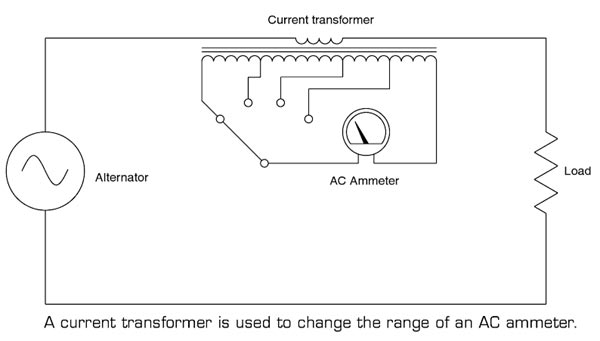
Ques.33. Which of the following produces braking torque in induction type energy meter? (SSC-2018 Set-4)
- Air Dampers
- Eddy current
- Spring
- Gravity
Answer.2. Eddy current Explanation:- An induction-type instrument can be used as an ammeter, voltmeter, or wattmeter, the induction-type energy meters are more popular. Induction-type single-phase energy meter is used invariably to measure the energy consumed in an AC circuit in a prescribed period where supply voltage and frequency are constant. The energy meter is an integrating instrument that measures the total quantity of electrical energy supplied to the circuit in a given period. Principle The basic principle of the induction-type energy meter is electromagnetic induction. When AC flows through two suitably located coils (current coil and potential coil), they produce the rotating magnetic field that is cut by the metallic disc suspended between the coils, and thus, an emf is induced in the disc that circulates eddy currents in it. By the interaction of the rotating magnetic field and eddy currents, electromagnetic torque is developed that causes the disc to rotate. This is the same principle that is applied in single-phase induction motors. A single-phase energy meter has four essential parts: Operating System The operating system consists of two electromagnets. The cores of these electromagnets are made of silicon steel laminations. The coils of one of these electromagnets (series magnet) are connected in series with the load and are called the current coil. The other electromagnet (shunt magnet) is wound with a coil that is connected across the supply, called the pressure coil. The pressure coil, thus, carries a current that is proportional to supply voltage. Shading bands made of copper are provided on the central limb of the shunt magnet. Shading bands, as will be described later, are used to bring the flux produced by a shunt magnet exactly in quadrature with the applied voltage. Moving System The moving system consists of a light aluminum disc mounted on a spindle. The disc is placed in the space between the series and shunt magnets. The disc is so positioned that it intersects the flux produced by both the magnets. The deflecting torque on the disc is produced by an interaction between these fluxes and the eddy current they induce in the disc. In energy meters, there is no control spring as such, so that there is the continuous rotation of the disc. Braking System The braking system consists of a braking device which is usually a permanent magnet positioned near the edge of the aluminum disc. The arrangement is shown in Figure. The emf induced in the aluminum disc due to relative motion between the rotating disc and the fixed permanent magnet (brake magnet) induces an eddy current in the disc. When disc rotates in the air gap, eddy currents are induced in the disc which opposes the cause producing them i.e. relative motion of disc with respect to the magnet. This eddy current, while interacting with the brake magnet flux, produces a retarding or braking torque. This braking torque is proportional to the speed of the rotating disc. When the braking torque becomes equal to the operating torque, the disc rotates at a steady speed. The position of the permanent magnet with respect to the rotating disc is adjustable. Therefore, braking torque can be adjusted by shifting the permanent magnet to different radial positions with respect to the disc. Registering System The function of a registering or counting system is to continuously record a numerical value that is proportional to the number of revolutions made by the rotating system.Induction-type Single-phase Energy Meter
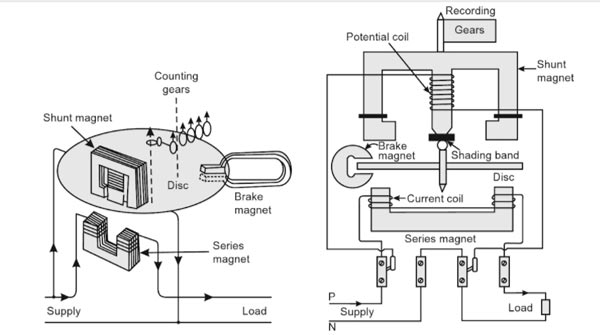
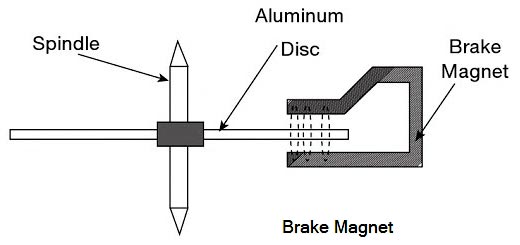
Ques.34. Which of the following can be used to measure frequency? (SSC-2018 Set-4,5)
- Anderson’s Bridge
- De-Sauty’s Bridge
- Owen’s Bridge
- Wien’s Bridge
Answer.4. Wien’s Bridge Explanation:- Wien’s bridge is primarily used for the determination of an unknown frequency. However, it can be used for various other applications including capacitance measurement, in harmonic distortion analyzers, where it is used as the notch filter. and also in audio and HF oscillators. Wien’s bridge is frequency sensitive. Thus, unless the supply voltage is purely sinusoidal, achieving balance may be troublesome, since harmonics may disturb the balance condition. Use of filters with the null detector in such cases may solve the problem. Note:- The inductance of an inductive coil is generally measured by the usual inductive circuit like Maxwell-Wein Bridge, Hay Bridge, Anderson’s bridge, Owen’s Bridge The Anderson’s bridge gives the accurate measurement of the self-inductance of the circuit. De-Sauty’s Bridge is used to measure the value of unknown capacitance in terms of standard capacitance.Wien’s Bridge
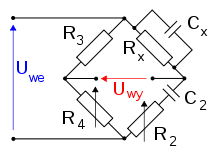
Ques.35. Ammeter and voltmeter are connected across the load in _______ and _______ respectively. (SSC-2018 Set-5)
- Series, Parallel
- Parallel, Series
- Series, Series
- Parallel, Parallel
Answer.1. Series, Parallel Explanation:- The Voltmeter is connected in parallel with the Load Voltage measures the Potential difference between two points. V=IR ( ohms law) A voltmeter is used to determine the voltage across 2 points of resistance in a circuit. For this purpose, it obviously has to be in contact with both the points across its 2 ends to give the reading for the potential difference of the 2 points. If it is connected in series, it will be in contact with only 1 point at a time. However, voltmeters have very high resistance so that they pull minimum current possible towards them, thus preventing a wrong current reading. Now if it is connected in series then no current will be there in the circuit due to its high resistance. Hence it is connected in parallel to the load across which the potential difference is to be measured. An ammeter is connected in series with the load To measure current, you want most of the current to pass through it. Hence ammeter is connected in series with the low resistance An ammeter measures the value of current flowing in the circuit, so current should flow inside ammeter to give proper result. it acts like a closed switch so it indicates the current. And it has very low resistance to ensure the correct measurement of current in the circuit. If it is connected in parallel across any load then all current in the circuit will choose the lower resistive path (i.e ammeter) to cause its circuit to be damaged. Hence it is used in series.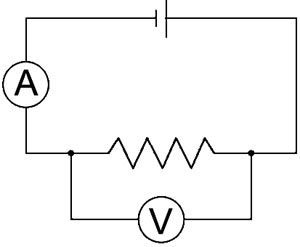
Ques.36. The deflection sensitivity of the CRO is 10 m/V. What is the value of the deflection factor (in V/m)? (SSC-2018 Set-5)
- 10
- 0.1
- 1
- 0.01
Answer.2. 0.1 Explanation:- The deflection sensitivity of a magnetic deflection cathode ray tube is defined as the amount of spot deflection on the screen when the potential of 1 volt is applied to the deflection plate. In most CROs, the deflection sensitivity is expressed as the ratio of input voltage to the length of the trace. In the electrostatic deflection, the spot la deflected on the screen by applying voltages on the vertical or the horizontal deflecting plates. The dc or peak-to-peak ac voltage applied to the deflects ing plates to displace the spot by 1 mm on the screen is termed the deflection factor. The reciprocal of the deflection factor is called the deflection sensitivity. The deflection factor la usually expressed in V/mm and deflection sensitivity in mm/V. Deflection sensitivity of the CRO is given as Deflection sensitivity = 1/deflection factor Deflection sensitivity = 1/10 =0.1m/V
Ques.37. The current required for full-scale deflection of a voltmeter is 10 mA. Find the sensitivity (in ohms/V) of the voltmeter. (SSC-2018 Set-5)
- 100
- 10
- 0.01
- 0.001
Answer.1. 100 Explanation:- The sensitivity of a voltmeter is given in ohms per volt. It is determined by dividing the sum of the resistance of the meter (Rm) plus the series resistance (Rs), by the full-scale reading in volts. In equation form, sensitivity is expressed as follows: Sensitivity (S) = (Rm + Rs) ⁄ Vfld or Sensitivity (S) = Sensitivity = Ohm/Volt = 1/Volt/Ohm = 1/Ampere S = 1/10 × 10−3 = 100A S = 100 ohm/volt
Ques.38. Calculate the fastest rise time (in ms) a sine wave can have to be reproduced by a CRO if the bandwidth ranges from 0 Hz to 10 Hz. (SSC-2018 Set-5)
- 17.5
- 0.35
- 35
- 1.75
Answer.3. 35 Explanation:- Bandwidth Instruments that measure AC waveforms generally have some maximum frequency above which the measurement accuracy is degraded. This frequency is the bandwidth of the instrument and is usually defined as the frequency at which the instrument’s response has decreased by 3 dB. Rise Time Ideally, waveforms such as square waves and pulses change the voltage level instantaneously. In reality, waveforms tales some time to make an abrupt change, depending on the bandwidth of the system and other circuit parameters. The amount of time it takes for a waveform to transition from one voltage to another is called the rise time. (The rise time is normally measured at the 10% and 90% levels of the transition.) The bandwidth of a measuring instrument will limit the measured rise time of a pulse or square wave. For a typical instrument, the relationship between rise time and bandwidth is given by: Trise = 0.35/Bandwidth Trise = 0.35/10 = 0.035 = 35ms
Ques.39. Which of the following is NOT the correct representation of the balanced condition of the AC bridges? (SSC-2018 Set-5)
- I1 = I3, I2 = I4
- |Z1| + | Z4| = |Z2| + |Z3|
- θ1 + θ4 = θ2 + θ3
- |Z1|| Z3| = |Z2||Z4|
Answer.2. |Z1| + | Z4| = |Z2| + |Z3| Explanation:- A.C. bridges are electrical networks, based upon an extension of the Wheatstone* bridge principle, used for the determination of an unknown impedance by comparison with known impedances and for the determination of frequency. In general, they contain four impedance arms an A.C power supply and a balanced detector which is sensitive to alternating currents. It is more difficult to achieve balance in an a.c. bridge than in a d.c. bridge because both the magnitude and the phase angle of impedances are related to the balance condition. Balance equations are derived by using complex numbers. A.c. bridges provide precise methods of measurement of inductance and capacitance, as well as resistance. The balanced condition of A.C bridges The majority of well-known a.c. bridges are classified as four-arm bridges and consist of an arrangement of four impedances (in complex form, Z = R + jX), as shown in Figure. As with the d.c. Wheatstone bridge circuit, an a.c. the bridge is said to be ‘balanced’ when the current through the detector is zero (i.e. when no current flows between B and D ). if the current through the detector is zero, then the current I1 flowing in impedance Z1 must also flow in impedance Z2. Also, at balance, the current I4 flowing in impedance Z4 must also flow through Z3 At balance: The volt drop between A and B is equal to the vol drop between A and D, i.e. VAB = VAD i.e. I1Z1 = I4Z4 (both in magnitude and in phase) ———(1) The volt drop between B and C is equal to the vol drop between D and C, i.e. VBC = VDC i.e. I1Z2 = I4Z3 (both in magnitude and in-phase———-(2) Dividing equation 1 and 2 we get Z1Z3 = Z2Z4 Let θ1, θ2, θ3, θ4, be the phase angles. The product of the impedances must be carried out in the polar form where magnitudes get multiplied and phase angles get added. Z1∠θ1 × Z3∠θ3 = Z2∠θ2 × Z3∠θ4 Z1Z3 ∠θ1 + θ3 = Z2Z4 ∠θ2 + θ4 ∠θ1 + θ3 = ∠θ2 + θ4 Also when the bridge is balanced no current flow from the galvanometer hence I1 = I3, & I2 = I4 Thus the products of the magnitudes of the opposite arms must be equal while the sum of the phase angles of the opposite arms must be equal. The bridge must be balanced for both the conditions magnitude as well as phase. The phase angles depend on the components of the individual impedances. The phase angles are positive for the inductive impedances and negative for the capacitive impedances.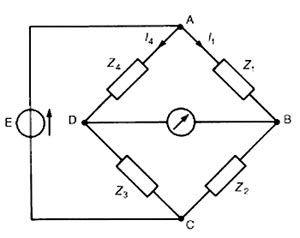
Ques.40. A 3 phase – 110 V motor has a power factor of 0.5. The two wattmeters connected measure the total input of 50 kW. Calculate the reading (in kW) of each wattmeter. (SSC-2018 Set-5)
- 0, 150
- 100, 50
- 0, 50
- 50,50
Answer.3. 0, 50 Explanation:- Total reading of Two wattmeters is W = W1 + W2 = 50 = W1 + W2 ———(1) Power factor cosφ = 0.5 = φ = 60° The power factor of the wattmeter is given as [latex]\tan 60 = \sqrt 3 \left( {\dfrac{{{w_1} – {w_2}}}{{{w_1} + {w_2}}}} \right)[/latex] W1 + W2 = W1 − W2 W2 = 0 Putting the value of W2 in eauation 1 we get 50 = W1 + 0 W1 = 50 kW Hence the reading of wattmeter is 50, 0 Method 2 The reading of two wattmeters can be expressed as W1 = VLILcos(30 − φ) When PF is 0.5 (φ = 60°) W1 = VLILcos30° = Positive W1 + W2 = W1 = Total Power = 50 ∴ total power is measured by wattmeter W1 alone One wattmeter shows zero reading for cosφ = 0.5. For all power factors between 0 to 0.5 W2 shows negative and W1 shows positive, for lagging p.f. Hence the reading of wattmeter is 50, 0
W2 = VLILcos(30 + φ)
W2 = VLILcos90° = 0°
